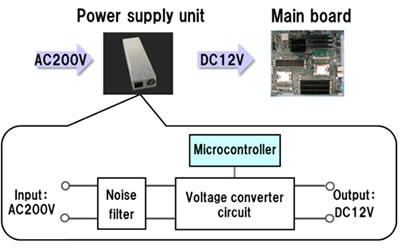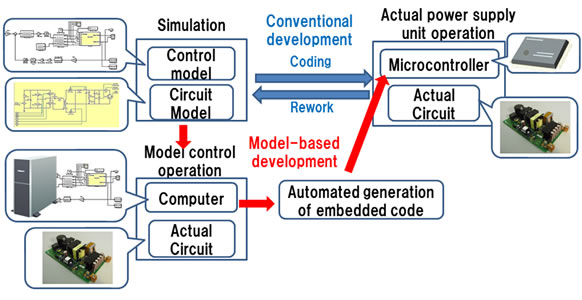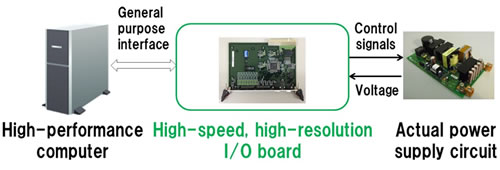Kawasaki, Japan, October 29, 2014
Fujitsu Laboratories Ltd. today announced that it has built the world's first development environment that enhances the efficiency and reliability of the development process for digital controlled power supply units in servers and other ICT equipment.
To deal with the growing complexity of controls as the performance and functionality of power supply units become increasingly sophisticated, the control of power supply units through software has shown significant promise. The challenge, however, has been to increase the efficiency of the software development process in the face of gaps between the performance of actual equipment and simulations in the design phase, increases in coding volumes, and the corresponding increase in software bugs from human error, resulting in an increasing amount of time needed for debugging and testing.
Fujitsu Laboratories has now developed a high-speed, high-resolution I/O board that is able to generate control signals at speeds of up to 150 kHz that are needed to control power supply units, and generate them in complete accordance with models at a high resolution of 150 picoseconds. In addition, by combining the board with automated embedded code generating technology, coding work is no longer needed, and a development environment has been created that verifies the appropriateness of the software control performance for the actual power supply unit and implements it in a microcontroller. As a result, it is possible to cut software development time to roughly one-third of previous methods.
Background
As the functionality of ICT equipment increases and the on-board electronics of automobiles advances, power supply units that provide stable energy to such equipment are important infrastructure.
In recent years, there has been a demand for increasingly sophisticated functionality in power supply units for greater energy conversion efficiency and coordination with servers and other ICT equipment. Accordingly, to address these needs, digital control for power supply units that execute control through embedded software in microcontrollers have begun to be employed (figure 1). As systems grow in complexity with increasingly sophisticated functionality, however, it becomes more difficult to identify whether the many problems in the form of gaps between the performance of actual equipment and simulated performance in the design phase are the fault of control circuits, control logic, or human error during coding, resulting in continual increases in time spent in development.
To respond to the increasingly sophisticated and diverse needs of power supply units such as for ICT equipment in a timely manner, it is essential to develop technologies that make the development process of power supply units fundamentally more efficient and reliable.
 Figure 1. Digital Controlled Power Supply unit
Figure 1. Digital Controlled Power Supply unit
Technological Issues
As a method to make the development process of embedded control systems for power supply units more efficient and reliable, a model-based development process, in which control logic specifications are represented by combining component models, and in which the development process proceeds with phased verification testing, from computer-based design and simulations to testing of the actual equipment, is considered to be promising. To implement model-based development methods in the development of digital power supply controls, it is necessary to realize a process in which the actual power supply circuit is operated by a control signal generated by the computer-based control model (figure 2).
The efficacy of model-based development methods have been validated at embedded control system development sites for the automobile and aerospace sectors, and these methods are becoming more widespread. Because the control frequencies required for power supply units in servers and other ICT equipment, at 100 kHz - 150 kHz, are low compared to frequencies of roughly 10 kHz or below for control systems used in the automobile and aerospace sectors, it is necessary to process control signals at 10 times the speed or higher. This has made it difficult to build a model-based development environment for power supply development.
 Figure 2. Conventional development method and model-based development
Figure 2. Conventional development method and model-based development
About the Technology
Now Fujitsu Laboratories has created a model-based development environment for developing digital power supply controls for ICT equipment. It combines a high-speed, high-resolution I/O board that, applying the power supply control signals generated by a high-performance computer based on a control model, is able to operate the circuit on the actual power supply unit, with the automated generation of embedded code (figure 3). This eliminates the need for the coding work in the verification tests to determine the appropriateness of the control model, which has undergone verification testing through simulations, in relation to the power supply unit of the actual equipment. Moreover, it is able to automatically generate the fast-acting embedded code for implementing the control model, whose appropriateness has been verified, in a microcontroller. Features of the technology are as follows.
- High-speed, high resolution I/O board
To apply the model-based developing environment built for the automobile sector to power supply units, a high-speed, high resolution I/O board that generates a power control signal was proprietarily developed to compensate for the inadequate capabilities.
To stabilize the output of the power supply unit, it is necessary to obtain the voltage level of the current output, determine the next control volume from that level, and control it for a set cycle. To complete the process, from obtaining the voltage to control signal output, within a set cycle each time, a new processing method was developed to have the processing of the calculation of the control volume overlap with the output of the control signals. This resulted in the world's first implementation of the capability of generating power supply control signals at speeds of up to 150 kHz (control cycle) and at a resolution of 150 picoseconds (time resolution).
- Automated generation of embedded code
The execution time of the automatically generated codes needs to be completed within in the expected time in the control microcontroller of the actual power control circuit after confirming the activity of the model control.
The control model is formed by combining component models, but the component models, for which the processing times are long, are substituted with unique component models generated by code tailored to microcontroller controls, thereby shortening the processing time.
 Figure 3. Development environment for digital controlled power supply units used in ICT equipment
Figure 3. Development environment for digital controlled power supply units used in ICT equipment
Results
Using the high-speed, high-resolution I/O board, a test can be conducted in which the control signals generated by a high-performance computer based on a virtual control model are added to the circuit of the actual power supply unit. In the test, when problems arise, the gap between the circuit model and the actual power supply circuit can be isolated. Moreover, after the problems are resolved, improving performance of the control logic can be achieved through tuning. In addition, through the automated generation of embedded code, based on the I/O board control logic's confirmation of the performance of the actual power supply circuit, the introduction of human error in generating the embedded code can be completely eliminated. By applying this newly developed technology in product development, it becomes possible to develop high performance, highly functional power supply units in approximately one third of the time compared to conventional methods while maintaining reliability, thereby enabling needs for power supply units to be addressed in a timely manner.
Future Plans
Fujitsu plans to apply this technology to its internal product development process, with a goal of practical implementation in fiscal 2015. Fujitsu will also consider applying this technology beyond high-performance ICT equipment, such as in wireless base stations, high level power controls of automobiles, and other areas, to meet a variety of power supply needs in a timely manner.
![]() E-mail: mbd-staff@ml.labs.fujitsu.com
E-mail: mbd-staff@ml.labs.fujitsu.com

